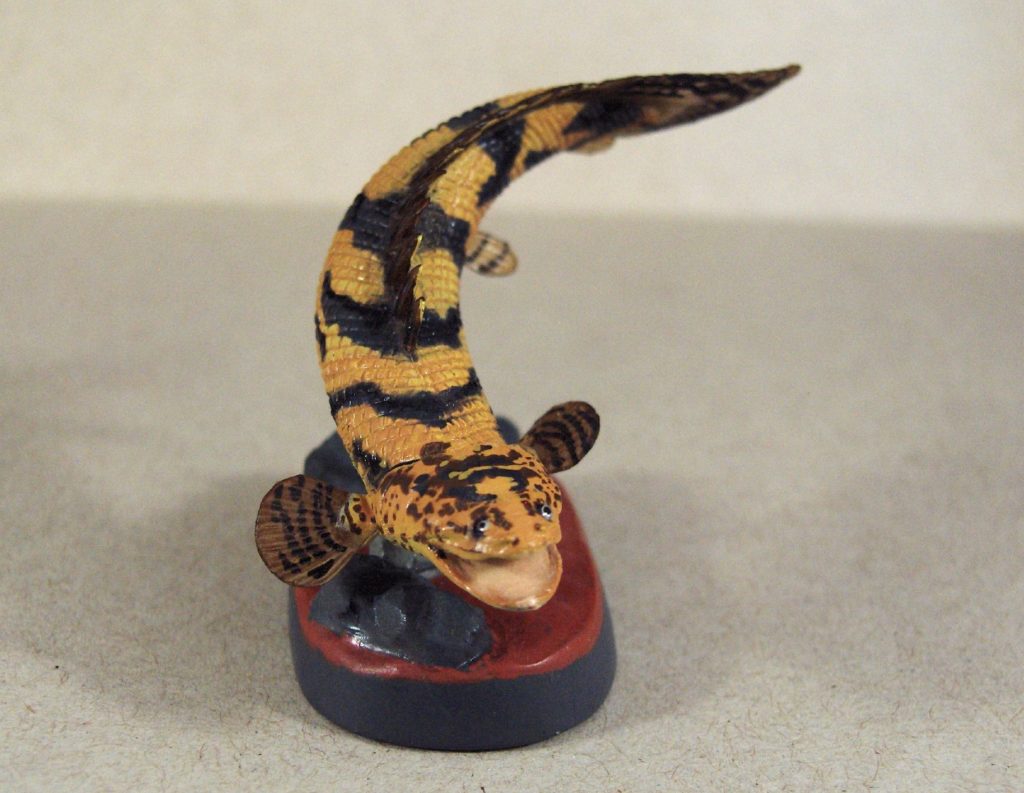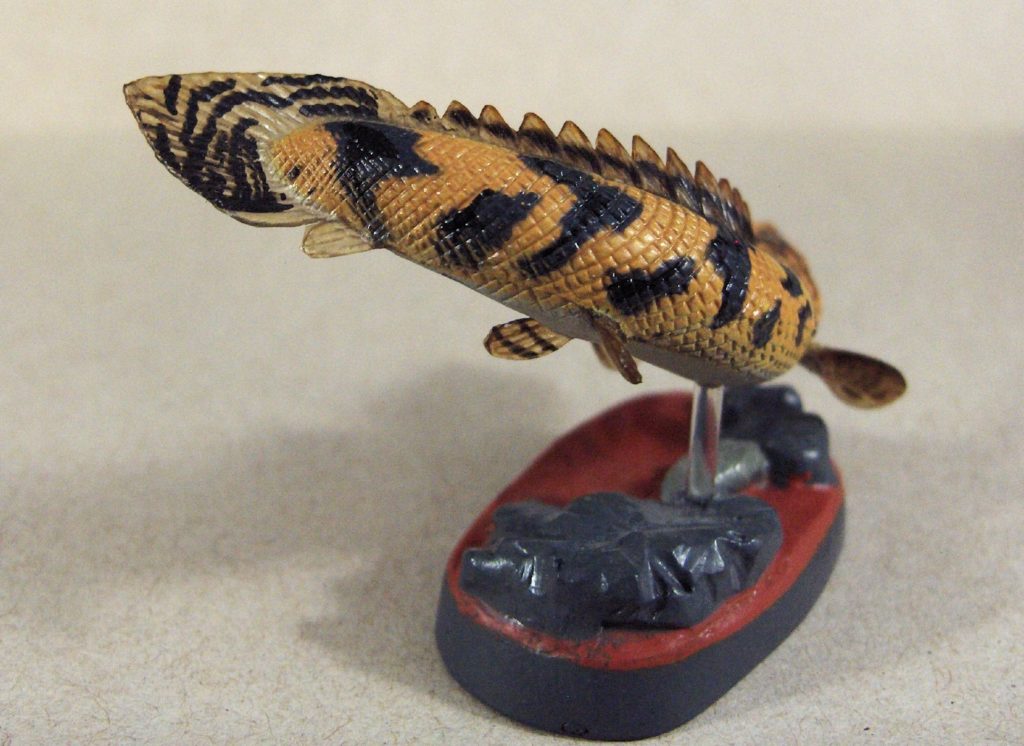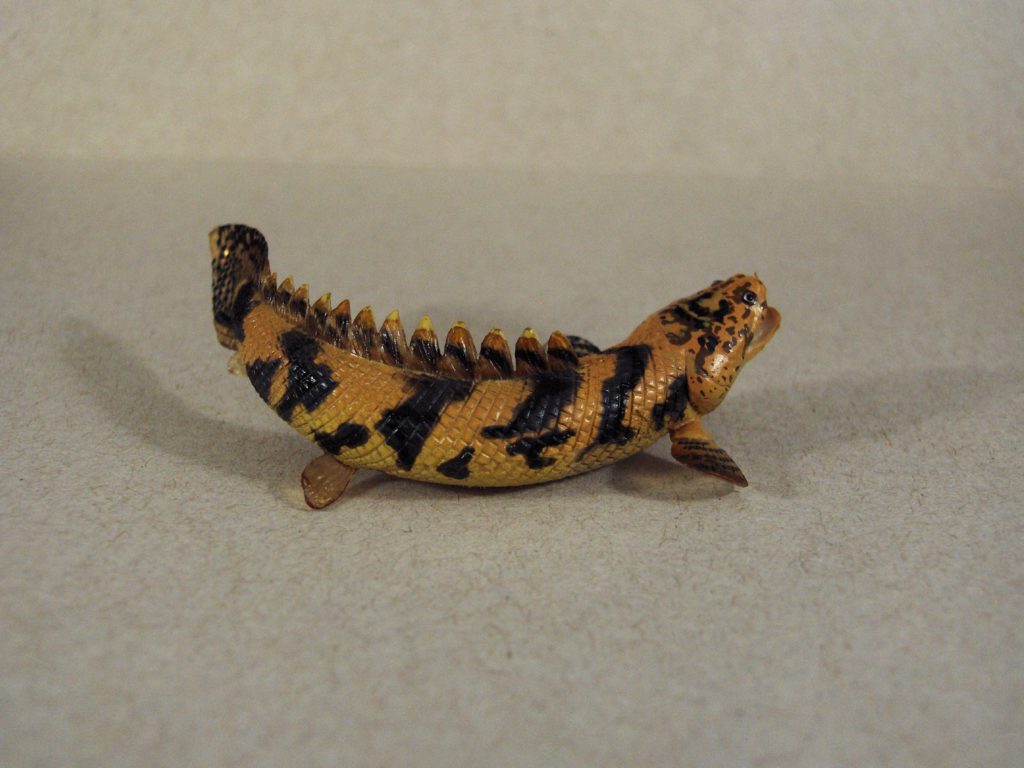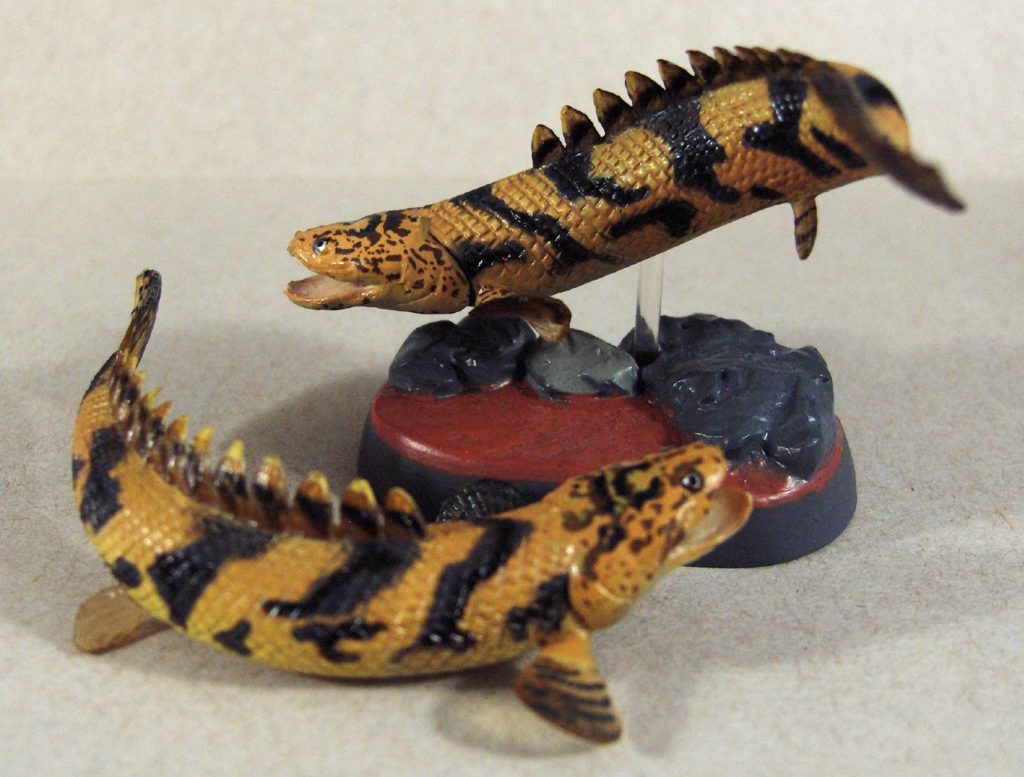For my next blog, I present the fish which I will declare “best fish” because they are my personal favorites of all time. I am speaking of course about the bichirs (family Polypteridae, order Polypteriformes), in this case the Colorata saddled bichir Polypterus endlicherii Heckel 1847. This figure was released in their Fossil Fishes box–for the 2nd & 3rd versions (it was not in the first one, but there was a nice Mekong Catfish exclusive to that one!). And just because they aren’t that familiar, I may go in a little bit more on what these unusual fish actually are!

The saddled bichir is one of about 12 living species and a few fossil species of the genus Polypterus. The only other living genus is the monotypic Erpetoichthys calabaricus (=Calamoichthys), the reedfish or ropefish. Bichirs (or ‘birchirs’) inhabit freshwater streams and lakes throughout northern and western Africa, and are very tolerant of low oxygen environments, since they are obligatory air-breathers with the help of a modified lung-like swim bladder. They are predators of pretty much anything that they can swallow which can include fish, worms, amphibians, arthropods, eggs…anything that fits. This model captures the very big mouth but does not show the teeth that would probably be visible even at this size. It also shows the nostril tubules to a very limited degree; on the figure they are little bumps, but stick out more on the real fish. It does capture the almost googly-eye like eyes that saddled bichirs have; the figure has them painted a shiny silver but in my experience the eyes aren’t always that shiny.

Polypterus species range from about 25cm to 100cm. The saddled bichir is one of those big ones, reaching as much as 76cm. The model itself is about 8cm long TL, although the twist and curve makes it a challenge to measure! It works out to a scale of about 1:10. Like most Colorata fish figures, it comes with a base and rod that can be shortened to more appropriately display the figure. Bichirs tend to stay low down in the water column, usually on the substrate, so it made sense to keep this figure down near the base.

The figure itself is brightly coloured in an orange-brown colour, banded by several black saddles. The colour abruptly fades to white on the belly, perhaps a little too abruptly, where the dark blotches are not present. All of the fins are a somewhat translucent material, painted in the same orange-ish colour, with black bands or blotches. The 12 separated dorsal pinnules, characteristic of the family, are sculpted in a fully upright position. This number is also appropriate for the species, which can number 11-14. The pectoral fins are also sculpted to demonstrate the fleshy lobes that are reminiscent of lobe-fin fishes like lungfish and coelacanths, but they are not closely related.

The skin is sculpted to demonstrate the heavy ganoid-scale armor that these fish possess. It is a little too uniform, and does not carry down to the belly (seriously, why did they ignore the belly?), when the scales should show more subtle size variations around the limbs and tail. These rhombic-shaped scales are a feature that bichirs share with other primitive modern fishes like gars, bowfins and sturgeon, but again, they are not directly related. This scaly skin, along with the big heads and spiny back, serves to give them an appropriately prehistoric look, and it is no wonder that they are sometimes sold as ‘dinosaur eels’ in the pet trade. Even though they aren’t eels. Not even close. I really need to stop saying what they aren’t related to. Except they aren’t all that related to anything…

It can rest on the ground fairly naturally.
So what is a bichir? They are the last remnant of a group of bony fish called Cladistia that is otherwise only known from the late Palaeozoic…and then after a long time gap, with the first polypterid fossils from Cretaceous Africa (the only place the family has been found, as far as I can tell). As a group, they are the sister-group to all other ray-finned fishes, but that sparse fossil record makes determining the evolutionary path a challenge. But what is in their fossil record is pretty cool–bichirs were swimming in the coastal waters in Africa alongside Spinosaurus and other dinosaurs. There are a few different genera, including a giant polypterid known as Bawitius, which is estimated at about 3 metres long!

So, with all of that, would I recommend this figure? For collectors or kids?Well, yeah, I would recommend the whole Colorata set (all 3, if you’re patient and can find them) for collectors (I’m sure I’ll get to other figures eventually). Bichirs are one of those neat fish that appeal to some people and are completely unknown to most, so it’s nice to see them get a tiny bit of attention in figure form (seriously tiny…there are 3 figures of this species…and only a couple others at all beyond that, and I had to produce them myself). If nothing else, I would promote these just because I’ve been a fan of them since I first saw them in a fish shop when I was 12, and have kept them more or less continuously over the last (many) years. As for kids, the best thing about these figures is that the material is tough enough that they can be given as (kind of pricey) toys to kids, so they can experience just how weird nature can be! Or, do you have a late Cretaceous Africa diorama to flesh out? It would fit right in as a prehistoric giant! Find a way to get them from Japan! They are totally worth it!
Disclaimer: links to Ebay and Amazon on the AnimalToyBlog are affiliate links, so we make a small commission if you use them. Thanks for supporting us!



